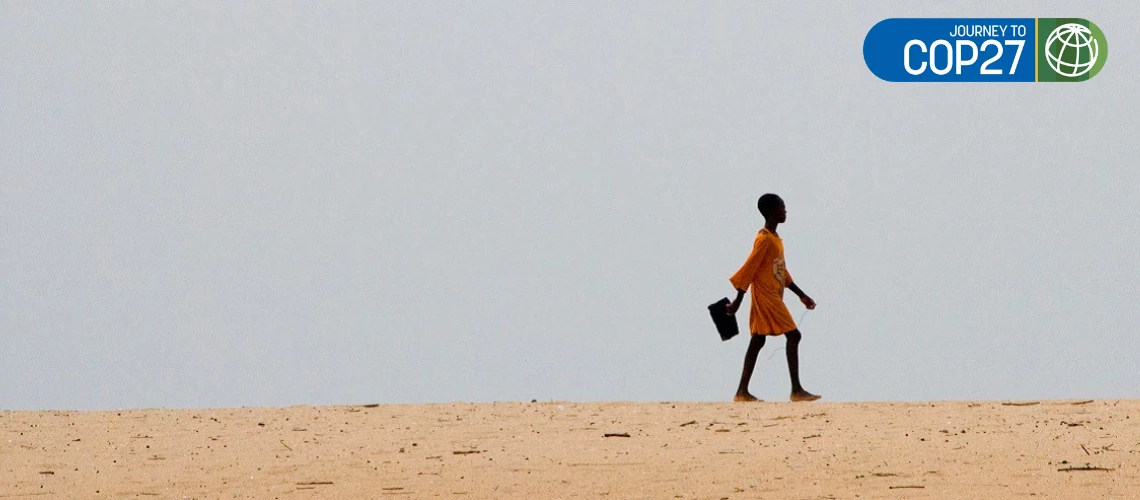 Girl walking to school in an arid landscape in Ghana
Girl walking to school in an arid landscape in Ghana
Women and girls often bear the brunt of the challenges facing our world. Climate change is no exception. Droughts, extreme heat, flooding, and increased exposure to disease are all linked to climate change and exacerbate the inequalities faced by adolescent girls living in poverty. The escalating climate emergency is increasing the chance of conflict and gender-based violence and undermining investments in human capital, with adolescent girls disproportionally affected. These impacts are evident on several fronts:
- Barriers to girls’ education are multiplied by the effects of climate change. Climate change and weather-related disasters already disrupt the education of approximately 37.5 million students each year. At least 200 million adolescent girls living in poverty face increased risk from these disasters. After disruptions to their education, UNICEF research in Pakistan finds that girls are less likely to return to school. If current trends continue, by 2025 climate change could prevent more than 12 million girls from completing their education each year.
- The negative impact of climate change on educational attainment undermines the socioeconomic prospects of girls. It also puts them at risk of teenage pregnancy and in some countries of early and forced marriage. Girls, especially in remote areas, are often a family’s go-to safety net when shocks occur: the first to take on increased household responsibilities such as collecting food and water and caring for family members. For example, a study of child vulnerability during droughts in Botswana found that 70% of the children taken out of school were girls, and 56% of girls reported spending more time and traveling longer distances to fetch water.
- Climate change can put girls at greater risk of child marriage. In periods of crisis, child marriage can be seen as a way for families to reduce severe economic hardship. This is often at the cost of her education and future options. Currently, more than 80% of adolescent girls are at risk of child marriage, early pregnancy, and school dropout across 10 countries in the Sahel - a region that is one of the most vulnerable to more extreme droughts, floods, and heatwaves.
- Climate disasters can greatly impact access to health services, which increases the risk of unplanned pregnancies and sexual and reproductive health challenges. Combining a lack of health services with a lack of access to education will mean girls’ understanding of their own sexual and reproductive health will also be limited. Climate disasters can also contribute to serious food insecurity and water crises. Girls are often the first to go without food when it is scarce, and they are unable to practice proper menstrual hygiene when water is inaccessible.
- As environmental stressors increase and resources dwindle, gender-based violence (GBV) and exploitation rise. Human trafficking and extreme labor exploitation can be used as a tool to maintain control of resources diminished by climate disasters. Moreover, young women whose livelihoods are jeopardized by climate change may be forced to trade sex. Climate-related displacement is also rising, and stressors from displacement can leave girls in displaced settings at risk of GBV. When girls are displaced, they are also half as likely to be in school as boys.
"If current trends continue, by 2025 climate change could prevent more than 12 million girls from completing their education each year."
Giving girls a fair shot
As policymakers and community leaders head into the 27th U.N. Climate Change Conference (COP27), they have a responsibility to understand the impacts of climate change on adolescent girls living in poverty, and the role these young women could play in climate adaptation. For every additional year of schooling a girl receives, her country’s resilience to climate disasters improves. Nevertheless, climate strategies are largely silent on girls and overlook the role of youth. No nationally determined contributions (NDCs) discuss investments in girls’ education; in fact, fewer than 10 NDCs mention education and only four mention girls. Yet education plays an important role in supporting climate resilience, mitigation, and adaptation.
For every additional year of schooling a girl receives, her country’s resilience to climate disasters improves. Nevertheless, climate strategies are largely silent on girls and overlook the role of youth.
For adolescent girls to have a fair shot, it is critical to help them complete a quality education and delay early marriage and pregnancy well beyond adolescence. These goals are challenging and multifaceted in the absence of emergencies but will be even more so in the face of looming climate change events. The World Bank Group’s Sahel Women’s Empowerment and Demographic Dividend project tackles the root causes of child marriage, adolescent fertility, and early school drop-out across West Africa while adapting to the challenges climate change presents. In Ethiopia and other countries, the Bank is supporting the provision of nutrition and health services to climate-vulnerable communities to build resilience to climate change-linked food insecurity and malnutrition.
In financing and programming decisions, policymakers, donors, and development actors must address climate change as a significant barrier for girls’ education and invest in building climate resilience in and through girls’ education at the international, national, school and community levels. Education programs must also be proactive in ensuring that girls affected by a climate crisis remain in school. It is also more essential than ever to ensure interventions address the multi-sectoral nature of challenges facing girls while targeting the most vulnerable girls such as those in adolescent fertility hotspots.
Finally, we must develop girls’ resilience, foster their knowledge of climate mitigation and adaptation strategies, and prepare them for green jobs. To support a just transition where girls are not left behind, a green learning agenda can build green skills while deliberately tackling gender inequality and supporting girls to transition into green jobs and careers. Girls are integral to climate change solutions precisely because they are disproportionately affected by the adverse effects of climate change. We cannot afford to leave them behind.


Join the Conversation